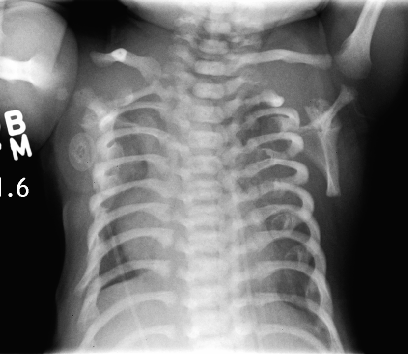Short-Rib Thoracic Dysplasia 5 With Or Without Polydactyly

A number sign (#) is used with this entry because of evidence that short-rib thoracic dysplasia-5 with or without polydactyly (SRTD5) is caused by homozygous mutation in the WDR19 gene (608151) on chromosome 4p14. One such patient has been reported.
DescriptionShort-rib thoracic dysplasia (SRTD) with or without polydactyly refers to a group of autosomal recessive skeletal ciliopathies that are characterized by a constricted thoracic cage, short ribs, shortened tubular bones, and a 'trident' appearance of the acetabular roof. SRTD encompasses Ellis-van Creveld syndrome (EVC) and the disorders previously designated as Jeune syndrome or asphyxiating thoracic dystrophy (ATD), short rib-polydactyly syndrome (SRPS), and Mainzer-Saldino syndrome (MZSDS). Polydactyly is variably present, and there is phenotypic overlap in the various forms of SRTDs, which differ by visceral malformation and metaphyseal appearance. Nonskeletal involvement can include cleft lip/palate as well as anomalies of major organs such as the brain, eye, heart, kidneys, liver, pancreas, intestines, and genitalia. Some forms of SRTD are lethal in the neonatal period due to respiratory insufficiency secondary to a severely restricted thoracic cage, whereas others are compatible with life (summary by Huber and Cormier-Daire, 2012 and Schmidts et al., 2013).
There is phenotypic overlap with the cranioectodermal dysplasias (Sensenbrenner syndrome; see CED1, 218330).
For a discussion of genetic heterogeneity of short-rib thoracic dysplasia, see SRTD1 (208500).
Clinical FeaturesDe Vries et al. (2010) described 13 patients with Jeune syndrome, including a 22-year-old Dutch woman who was born to healthy, unrelated parents and had 1 healthy younger sib. At 1 year of age, she was evaluated for growth failure, abnormal chest shape, and short limbs. Skeletal radiographs showed a small, narrow thorax, brachydactyly of the fingers, short and broad diaphyses, wide metaphyses of the arms and legs, and short iliac bones with spiky protrusions. She had no history of respiratory difficulties, but was hospitalized at 3 years of age for a respiratory infection, at which time she was discovered to have elevated serum creatinine, proteinuria, and hypertension. At 4 years of age, she began peritoneal dialysis, and underwent renal transplantation at 5 years of age; rejection led to a second kidney transplant at 12 years of age. At 22 years of age she was living independently, working as a nurse, and had mildly impaired exercise tolerance. Ophthalmoscopy showed cataracts, attenuated arteries, and macular abnormalities, which were under investigation. De Vries et al. (2010) noted that with age, the thoracic malformation in these patients tended to become less pronounced and respiratory problems decreased, and that the prognosis of ATD appeared to be better than previously described.
Molecular GeneticsBredrup et al. (2011) analyzed the candidate gene WDR19 (608151) in 14 patients with Jeune syndrome. In a 22-year-old Dutch woman originally reported by de Vries et al. (2010), they identified homozygosity for a missense mutation in the WDR19 gene (L7P; 608151.0003). Her unaffected parents were heterozygous for the mutation, which was not detected in her unaffected sister.